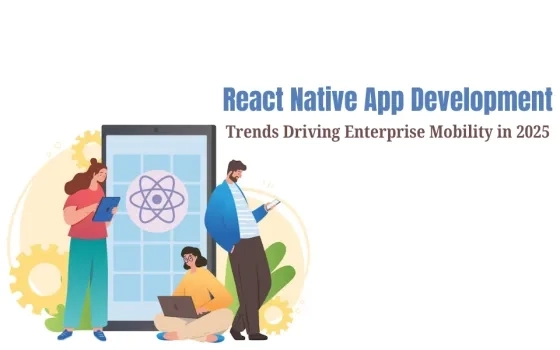Introduction
Enterprise mobility is the strategic approach that allows organizations to empower employees and customers through secure, seamless access to business services on mobile devices. It reflects a shift from traditional desktop-reliant systems to mobile-first infrastructures that support remote work, real-time communication, and on-the-go operations.
In 2025, the need for enterprise mobility has evolved beyond convenience—it's a business imperative. With increasing pressure on companies to deliver agile, data-driven, and scalable mobile solutions, React Native app development is playing a central role. Its ability to streamline the development process and deploy apps across iOS and Android with a single codebase makes it a go-to framework for enterprise-grade applications.
Moreover, cross-platform app development has emerged as a dominant trend, allowing businesses to cut costs and time-to-market without compromising user experience. React Native not only accelerates development but also ensures native-like performance, enabling developers to build feature-rich, enterprise-level applications that are both flexible and future-proof.
This blog explores the key trends in React Native app development that are shaping enterprise mobility solutions in 2025. From the shift toward cross-platform strategies to innovations in DevOps, AI, and security, we’ll uncover how enterprises can modernize and scale effectively in the mobile-first era.
Why Enterprise Mobility Matters More in 2025?
The landscape of business operations has been permanently reshaped by the pandemic, leading to a massive surge in remote and hybrid work environments. In 2025, this trend has matured, with enterprise mobility becoming central to business continuity and workforce productivity.
Organizations now rely heavily on enterprise mobile app development to keep teams connected and operations agile. Real-time collaboration tools, mobile dashboards, and instant access to enterprise data are no longer optional—they're essential. Secure access to systems from anywhere ensures employees remain productive regardless of location, while customers expect services to be mobile-first and on-demand.
This shift marks a move away from static, desktop-based infrastructures to highly dynamic mobile ecosystems. Mobile-first digital strategies are proving vital for staying competitive, offering better user experiences and driving operational efficiency.
Additionally, enterprise mobility offers significant cost-saving advantages. Maintaining one mobile application instead of separate desktop and legacy systems reduces overhead, while enabling faster updates and feature rollouts. Flexibility is another benefit—businesses can scale quickly, respond to market changes, and meet evolving user expectations with minimal friction.
As enterprise app modernization continues, investing in scalable and secure mobile platforms has become a strategic necessity. React Native’s ability to support these transitions is a key reason why it’s being widely adopted for enterprise mobility solutions in 2025.
The Shift Toward Cross-Platform Development
In 2025, enterprises are prioritizing cross-platform app development as the standard approach to delivering scalable mobile applications. Traditional native development, while powerful, often results in higher costs, longer timelines, and fragmented user experiences. Cross-platform frameworks like React Native solve these issues by enabling developers to write a single codebase for both iOS and Android.
This approach is not just cost-effective; it's strategically sound. Enterprises can reduce time-to-market, streamline maintenance, and allocate resources more efficiently. For businesses managing large user bases across various platforms and devices, the ability to maintain consistent functionality and performance is a major win.
React Native app development is leading this shift due to its flexibility, performance, and ecosystem maturity. It supports a robust developer community, third-party libraries, and tools that simplify integration with backend systems, DevOps workflows, and enterprise security protocols. Companies like Meta and Microsoft have leveraged React Native to power critical apps, further proving its scalability and enterprise-readiness.
Cross-platform development also enhances team collaboration. Developers, testers, and designers can work more cohesively using shared components and unified design systems. This accelerates iteration cycles and ensures a seamless user experience across platforms.
As enterprises focus on mobility, the move to cross-platform development is not just a trend—it’s a long-term strategy that delivers measurable ROI and adaptability in an ever-changing digital world.
Key React Native App Development Trends
React Native is evolving rapidly to meet enterprise demands. In 2025, several key trends are driving its adoption:
1. AI & ML Integration
Enterprises are embedding artificial intelligence and machine learning into mobile apps to enable personalization, automate workflows, and enhance decision-making. React Native supports seamless integration with AI APIs and models, offering intelligent, context-aware experiences.
2. New React Native Architecture
The rollout of Fabric and TurboModules has transformed how React Native apps render and communicate with native modules. These changes drastically improve load times, reduce memory usage, and enhance performance for large-scale enterprise applications.
3. Super Apps Development
React Native is increasingly used to build "super apps"—multi-service platforms that combine messaging, payments, booking, and more. Its modular architecture makes it ideal for scaling complex, multifunctional enterprise solutions.
4. Enhanced DevOps and CI/CD Pipelines
Enterprise teams now rely on advanced DevOps integrations. React Native’s compatibility with tools like Fastlane, Bitrise, and GitHub Actions makes continuous integration and delivery faster and more reliable.
5. Improved Native Module Support
With improved support for native modules, enterprises can access advanced device features and platform-specific APIs without compromising the benefits of cross-platform development.
These trends position React Native as a future-ready framework for enterprise app modernization, enabling companies to innovate faster and deliver superior mobile experiences.
Building Scalable Enterprise Mobile App Solutions
Enterprise mobile apps must be scalable, secure, and tailored to complex workflows. Here are the critical building blocks for scalable solutions in 2025:
1. Role-Based Access & User Permissions
Modern enterprise apps must support multiple user roles—employees, admins, partners—with custom permissions and data access layers to maintain compliance and data integrity.
2. Offline Capabilities
Mobile apps should function reliably even in low-connectivity scenarios. Features like offline data sync and local caching ensure business continuity and a better user experience in remote settings.
3. Real-Time Data Sync
Enterprises need real-time dashboards, notifications, and collaboration tools. Using services like Firebase or WebSockets in React Native apps makes it easier to deliver responsive user experiences.
4. CRM and ERP Integration
Enterprise apps must integrate smoothly with systems like Salesforce, SAP, or Oracle. React Native’s bridge and third-party SDKs facilitate seamless connectivity with these legacy platforms.
5. Advanced Security Protocols
Security remains non-negotiable. Features like biometric authentication, encrypted data transmission, and secure session handling must be built into every enterprise-grade app.
Scalability goes beyond just user load—enterprise apps must adapt to evolving business needs. Whether it’s expanding features, adding new modules, or onboarding more users, React Native provides the flexibility to grow without starting from scratch. This makes it a preferred foundation for enterprise mobility solutions in 2025 and beyond.
Future Outlook & Strategic Recommendations
The future of enterprise mobility is being shaped by agile frameworks and future-ready platforms, and React Native is leading the charge.
1. Growing Enterprise Adoption
React Native is no longer limited to startups. Tech giants like Microsoft (Teams) and Meta (Facebook, Instagram) are investing heavily in it, validating its scalability and maturity for enterprise use.
2. Community & Ecosystem Maturity
By 2025, the React Native community has grown into one of the most active in mobile development. Frequent updates, extensive documentation, and plugin availability simplify enterprise integration and reduce development risk.
3. High ROI from Modular Architecture
Investing in modular, reusable components reduces development effort over time. Enterprises can roll out updates faster, share components across apps, and easily extend functionalities.
4. Strategic Recommendations
CTOs and product leaders should:
Prioritize flexible frameworks like React Native.
Invest in DevOps and testing automation.
Focus on app modularity to reduce technical debt.
Embrace cloud-native infrastructure for scalability.
Enterprise leaders who align their mobile strategy with these trends will be better positioned to respond to future disruptions. Enterprise app modernization using React Native is not just about keeping up—it’s about staying ahead.
Conclusion:
Enterprise mobility in 2025 is more than just a digital transformation buzzword—it’s the foundation of how modern organizations operate and compete. With mobile-first strategies at the forefront, businesses are redefining how work gets done, how services are delivered, and how users interact with technology.
React Native app development has emerged as a cornerstone of this evolution. It enables companies to build powerful, scalable, and secure mobile apps that run seamlessly across platforms, reducing cost and complexity while accelerating innovation. Combined with the benefits of cross-platform app development, enterprises can deploy solutions faster and respond to market needs with unmatched agility.
From integrating AI and super app features to ensuring real-time access and robust security, React Native meets the demands of the modern enterprise. The framework’s ability to support continuous deployment, modular architecture, and backend integrations makes it an ideal choice for enterprise app modernization.
In a mobile-first world, competitive advantage belongs to those who can scale efficiently and securely. Enterprise mobility solutions built on robust technologies like React Native offer agility, insight, and scale—all critical in a volatile digital economy.
Investing now means building a foundation for long-term success. Enterprises that act today will lead tomorrow’s mobile-driven world.

















